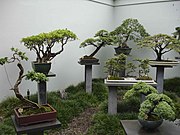...
Common styles


There are many different styles of bonsai, but some are more common than others. These include formal upright, slant, informal upright, cascade, semi-cascade, raft, literati, and group / forest.
- The formal upright style, or Chokkan, is just as the name suggests, and is characterized by a straight, upright, tapering trunk. The trunk and branches of the informal upright, or Moyogi, may incorporate pronounced bends and curves, but the apex of the informal upright is always located directly over the roots.
- Slant style, or Shakan bonsai are similar to the straight trunks of formal upright trees, but the trunk emerges from the soil at an angle, and the apex of the bonsai will extend to the left or right of the root base.
- Cascade style, or Kengai bonsai are modeled after some trees that grow over water or on the sides of mountains. The apex, or tip, of Semi-cascade style, or Han Kengai bonsai extend just beneath the lip of the bonsai pot, whereas the apex of a (full) cascade style will fall below the base of the pot.
- Raft style, or Netsunari bonsai mimic a natural phenomenon that occurs when a tree that has been toppled (typically due to erosion or another natural force) and branches along the exposed side of the trunk form a group of new trunks. Sometimes, roots will develop from buried portions of the trunk. Raft style bonsai can incorporate other treatments, such as sinuous, straight-line, slanting styles. These all give the illusion of a group of trees, but are actually the branches of a tree planted on its side.
- The literati style is characterized by an emphasis on the bare trunk line, with branches reduced to a minimum, typically placed higher up on a long, contorted trunk. Their style is inspired by the Chinese brush paintings, like those found in the ancient text,The Mustard Seed Garden Manual of Painting, depicting pine trees that grew in harsh climates, struggling to reach sunlight. In Japan, the literati style is known as bunjin-gi (文人木?). (Bunjin is a translation of the Chinese word wenren meaning "scholars practiced in the arts" and gi is a derivative of the Japanese word, ki, for "tree").
- The group or forest style, or Yose Uye, comprises a number of trees (typically an odd number if there are three or more trees) planted together in a pot. The trees are usually the same species, but a variety of heights are employed to add visual interest and to reflect the age differences encountered in mature forests.
- The Root over rock style, or Sekijoju, is a style in which the roots of a tree (typically a fig tree) are wrapped around a rock. The rock is at the base of the trunk, with the roots exposed to a certain extent.
- The Broom style, or Hokidachi is suited for trees with extensive, fine branching. The trunk is straight and upright. It branches out in all directions about 1/3 of the way up the entire height of the tree. In this manner the branches and leaves form a ball-shaped crown which can also be very beautiful during the winter months.
- The Multi Trunk style, or Ikadabuki. All the trunks grow out of one root system, and it truly is one single tree. All the trunks form one crown of leaves, in which the thickest and most developed trunk forms the top.
- The Growing in a Rock, or Ishizuke In this style the roots of the tree are growing in the cracks and holes of the rock. This means that there is just not much room for the roots to develop and take up nutrients. Trees which grow in rocks will never look really healthy, thus it should be visible that the tree has to struggle to survive.
Size Classifications
Additionally, bonsai are classed by size. Sizes of Bonsai include:
- Mame - tiny bonsai
- Keshi-tsubu, up to 2.5cm
- Shito, 2.5-7.5 cm tall.
- Shohin - small bonsai
- Gafu, 13cm-20cm
- Komono, up to 18cm
- Myabi, 15cm-25cm
- Kifu - medium bonsai
- Katade-mochi, up to 40cm
- Chu/Chuhin - medium to large, 40-60 cm tall
- Dai/Daiza - large bonsai
- Omono, up to 120cm
- Bonju, over 100cm tall
Note that sources disagree on the exact range of sizes given for a category.
There are a number of specific techniques and styles associated with mame and shito sizes, the smallest bonsai. These are often small enough to be grown in thimble-sized pots,[citation needed] and due to their minuscule size require special care and adhere to different design conventions.






No comments:
Post a Comment